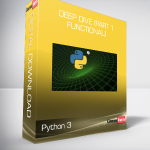🎈 Happy New Year 2025!
Use code HAPPY2025 to get 30% OFF on all products!
Limited-time offer. Don't miss out!
Python 3: Deep Dive (Part 1 – Functional)
Original price was: $199.00.$42.00Current price is: $42.00.
(This course is available for immediate delivery!)This is not a beginner course – if you’ve been coding Python for a week or a couple of months, you probably should keep writing Python for a bit more before tackling this series.File size: 9.72 GB
- Description
- Reviews (0)
Description
Python 3: Deep Dive (Part 1 – Functional)
What you’ll learn
An in-depth look at variables, memory, namespaces and scopes
A deep dive into Python’s memory management and optimizations
In-depth understanding and advanced usage of Python’s numerical data types (Booleans, Integers, Floats, Decimals, Fractions, Complex Numbers)
Advanced Boolean expressions and operators
Advanced usage of callables including functions, lambdas and closures
Functional programming techniques such as map, reduce, filter, and partials
Create advanced decorators, including parametrized decorators, class decorators, and decorator classes
Advanced decorator applications such as memoization and single dispatch generic functions
Use and understand Python’s complex Module and Package system
Idiomatic Python and best practices
Understand Python’s compile-time and run-time and how this affects your code
Avoid common pitfalls
Get Python 3: Deep Dive (Part 1 – Functional) download
Course content
Expand all 158 lectures44:38:14
–Introduction
18:55
Course Overview
Preview
18:08
Pre-Requisites
Preview
00:37
Code Projects and Notebooks
Preview
00:09
–A Quick Refresher – Basics Review
02:22:54
Introduction
Preview
01:43
The Python Type Hierarchy
05:51
Multi-Line Statements and Strings
21:49
Variable Names
11:00
Conditionals
07:38
Functions
12:27
The While Loop
14:25
Break, Continue and the Try Statement
10:24
The For Loop
17:20
Classes
40:17
–Variables and Memory
03:01:45
Introduction
Preview
02:54
Variables are Memory References
08:20
Reference Counting
14:21
Garbage Collection
26:38
Dynamic vs Static Typing
05:28
Variable Re-Assignment
04:48
Object Mutability
15:21
Function Arguments and Mutability
17:28
Shared References and Mutability
09:36
Variable Equality
14:22
Everything is an Object
13:58
Python Optimizations: Interning
09:13
Python Optimizations: String Interning
19:10
Python Optimizations: Peephole
20:08
–Numeric Types
07:54:31
Introduction
Preview
02:58
Integers: Data Types
18:06
Integers: Operations
24:25
Integers: Constructors and Bases – Lecture
29:34
Integers: Constructors and Bases – Coding
20:22
Rational Numbers – Lecture
14:26
Rationals Numbers – Coding
12:33
Floats: Internal Representations – Lecture
19:52
Floats: Internal Representations – Coding
04:56
Floats: Equality Testing – Lecture
18:42
Floats: Equality Testing – Coding
14:40
Floats: Coercing to Integers – Lecture
09:38
Floats: Coercing to Integers – Coding
05:03
Floats: Rounding – Lecture
25:21
Floats: Rounding – Coding
13:33
Decimals – Lecture
16:49
Decimals – Coding
10:26
Decimals: Constructors and Contexts – Lecture
10:05
Decimals: Constructors and Contexts – Coding
10:28
Decimals: Math Operations – Lecture
09:32
Decimals: Math Operations – Coding
13:30
Decimals: Performance Considerations
10:29
Complex Numbers – Lecture
11:28
Complex Numbers – Coding
14:16
Booleans
20:59
Booleans: Truth Values – Lecture
Preview
09:08
Booleans: Truth Values – Coding
14:47
Booleans: Precedence and Short-Circuiting – Lecture
21:10
Booleans: Precedence and Short-Circuiting – Coding
13:37
Booleans: Boolean Operators – Lecture
Preview
18:00
Booleans: Boolean Operators – Coding
Preview
14:45
Comparison Operators
20:53
–Function Parameters
04:05:16
Introduction
Preview
01:05
Argument vs Parameter
03:43
Positional and Keyword Arguments – Lecture
13:04
Positional and Keyword Arguments – Coding
06:21
Unpacking Iterables – Lecture
13:00
Unpacking Iterables – Coding
21:09
Extended Unpacking – Lecture
Preview
17:50
Extended Unpacking – Coding
Preview
29:04
*args – Lecture
06:00
*args – Coding
11:47
Keyword Arguments – Lecture
09:23
Keyword Arguments – Coding
14:18
**kwargs
10:28
Putting it all Together – Lecture
13:25
Putting it all Together – Coding
17:25
Application: A Simple Function Timer
19:08
Parameter Defaults – Beware!!
18:44
Parameter Defaults – Beware Again!!
19:22
–First-Class Functions
05:18:53
Introduction
Preview
04:05
Docstrings and Annotations – Lecture
15:58
Docstrings and Annotations – Coding
15:02
Lambda Expressions – Lecture
Preview
12:09
Lambda Expressions – Coding
14:59
Lambdas and Sorting
15:56
Challenge – Randomize an Iterable using Sorted!!
02:55
Function Introspection – Lecture
19:30
Function Introspection – Coding
28:35
Callables
14:46
Map, Filter, Zip and List Comprehensions – Lecture
21:42
Map, Filter, Zip and List Comprehensions – Coding
21:14
Reducing Functions – Lecture
25:51
Reducing Functions – Coding
21:10
Partial Functions – Lecture
11:12
Partial Functions – Coding
25:32
The operator Module – Lecture
15:34
The operator Module – Coding
32:43
–Scopes, Closures and Decorators
08:34:18
Introduction
Preview
01:31
Global and Local Scopes – Lecture
34:54
Global and Local Scopes – Coding
15:40
Nonlocal Scopes – Lecture
22:17
Nonlocal Scopes – Coding
14:36
Closures – Lecture
38:35
Closures – Coding
32:04
Closure Applications – Part 1
15:37
Closure Applications – Part 2
18:40
Decorators (Part 1) – Lecture
21:06
Decorators (Part 1) – Coding
20:58
Decorator Application (Timer)
35:16
Decorator Application (Logger, Stacked Decorators)
23:46
Decorator Application (Memoization)
29:14
Decorators (Part 2) – Lecture
11:44
Decorators (Part 2) – Coding
25:57
Decorator Application (Decorator Class)
09:40
Decorator Application (Decorating Classes)
48:23
Decorator Application (Dispatching) – Part 1
31:45
Decorator Application (Dispatching) – Part 2
35:45
Decorator Application (Dispatching) – Part 3
26:50
–Tuples as Data Structures and Named Tuples
03:31:18
Introduction
Preview
03:18
Tuples as Data Structures – Lecture
19:01
Tuples as Data Structures – Coding
25:24
Named Tuples – Lecture
27:48
Named Tuples – Coding
35:13
Named Tuples – Modifying and Extending – Lecture
14:25
Named Tuples – Modifying and Extending – Coding
21:46
Named Tuples – DocStrings and Default Values – Lecture
13:30
Named Tuples – DocStrings and Default Values – Coding
15:46
Named Tuples – Application – Returning Multiple Values
06:22
Named Tuples – Application – Alternative to Dictionaries
28:45
–Modules, Packages and Namespaces
05:43:11
Introduction
Preview
03:01
What is a Module?
24:30
How does Python Import Modules?
49:32
Imports and importlib
27:39
Import Variants and Misconceptions – Lecture
13:59
Import Variants and Misconceptions – Coding
27:03
Reloading Modules
18:29
Using __main__
27:01
Modules Recap
13:02
What are Packages? – Lecture
20:24
What are Packages ? – Coding
27:11
Why Packages?
13:07
Structuring Packages – Part 1
36:41
Structuring Packages – Part 2
27:27
Namespace Packages
10:37
Importing from Zip Archives
03:28
–Extras
03:47:12
Introduction
Preview
03:40
Additional Resources
Preview
12:53
Python 3.6 Highlights
Preview
07:49
Python 3.6 – Dictionary Ordering
Preview
19:45
Python 3.6 – Preserved Order of kwargs and Named Tuple Application
05:32
Python 3.6 – Underscores in Numeric Literals
03:38
Python 3.6 – f-Strings
09:19
Random: Seeds
17:26
Random Choices
26:07
Random Samples
07:02
Timing code using *timeit*
16:17
Don’t Use *args and **kwargs Names Blindly
07:35
Command Line Arguments
01:00:07
Sentinel Values for Parameter Defaults
11:02
Simulating a simple switch in Python
19:00
Requirements
Basic introductory knowledge of Python programming (variables, conditional statements, loops, functions, lists, tuples, dictionaries, classes).
You will need Python 3.6 or above, and a development environment of your choice (command line, PyCharm, Jupyter, etc.)
Description
Hello!
This is Part 1 of a series of courses intended to dive into the inner mechanics and more complicated aspects of Python 3.
This is not a beginner course – if you’ve been coding Python for a week or a couple of months, you probably should keep writing Python for a bit more before tackling this series.
On the other hand, if you’re now starting to ask yourself questions like:
I wonder how this works?
is there another way of doing this?
what’s a closure? is that the same as a lambda?
I know how to use a decorator someone else wrote, but how does it work? Can I write my own?
why isn’t this boolean expression returning a boolean value?
what does an import actually do, and why am I getting side effects?
and similar types of question…
then this course is for you.
Please make sure you review the pre-requisites for this course – although I give a brief refresh of basic concepts at the beginning of the course, those are concepts you should already be very comfortable with as you being this course.
In this course series, I will give you a much more fundamental and deeper understanding of the Python language and the standard library.
Python is called a “batteries-included” language for good reason – there is a ton of functionality in base Python that remains to be explored and studied.
So this course is not about explaining my favorite 3rd party libraries – it’s about Python, as a language, and the standard library.
In particular this course is based on the canonical CPython. You will also need Jupyter Notebooks to view the downloadable fully-annotated Python notebooks.
It’s about helping you explore Python and answer questions you are asking yourself as you develop more and more with the language.
In Python 3: Deep Dive (Part 1) we will take a much closer look at:
Variables – in particular that they are just symbols pointing to objects in memory
Namespaces and scope
Python’s numeric types
Python boolean type – there’s more to a simple or statement than you might think!
Run-time vs compile-time and how that affects function defaults, decorators, importing modules, etc
Functions in general (including lambdas)
Functional programming techniques (such as map, reduce, filter, zip, etc)
Closures
Decorators
Imports, modules and packages
Tuples as data structures
Named tuples
To get the most out of this course, you should be prepared to pause the coding videos, and attempt to write code before I do! Sit back during the concept videos, but lean in for the code videos!
And after you have seen a code video, pause the course, and try things out yourself – explore, experiment, play with code, and see how things work (or don’t work! – that’s also a great way to learn!)
Who this course is for:
Anyone with a basic understanding of Python that wants to take it to the next level and get a really deep understanding of the Python language and its data structures.
Anyone preparing for an in-depth Python technical interview.
Get Python 3: Deep Dive (Part 1 – Functional) download
Below is Proof content:





Reviews
There are no reviews yet.